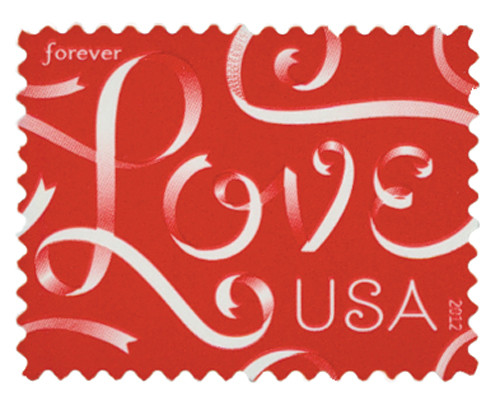
# 4626 - 2012 First-Class Forever Stamp - Love Series: Love Ribbons
U.S. #4626
2012 45¢ Love Ribbons
Love Series
Issue Date: February 14, 2012
City: Colorado Springs, CO
Quantity: 300,000,000
Printed By: Banknote Corporation of America for Sennett Security Products
Printing Method: Offset
Color: Multicolored
“Around her neck she wore a yellow ribbon...” The words from this 400-year-old song tell the story of a man who goes away and gives his sweetheart a ribbon to wear. In those days, ribbons were a sign of commitment. Women wore them in their hair or around their neck as a promise to wait for the return of their beloved. Knights carried their true love’s ribbons into battle, tucked safely in their armor.
In Medieval times, peddlers traveled through Europe selling ribbons made of exotic silk from the Orient woven with gold and silver. In 17th century French and British society, only nobility could afford the luxury items, which were made by peasants.
When the engine loom was invented, thin strips of brightly colored fabric became popular accents on men’s and women’s fashions from hats to shoes. Some garments were trimmed with as much as 250 yards of ribbon.
Though ribbons no longer cover clothing with such extravagance, they are still used today. A box sealed with a fancy bow adds to the value of the gift. A bride’s dress and flowers are adorned with satin streamers. Ribbons are still symbols of love, as they were when a yellow band was worn “for my lover who is far far away.”
U.S. #4626
2012 45¢ Love Ribbons
Love Series
Issue Date: February 14, 2012
City: Colorado Springs, CO
Quantity: 300,000,000
Printed By: Banknote Corporation of America for Sennett Security Products
Printing Method: Offset
Color: Multicolored
“Around her neck she wore a yellow ribbon...” The words from this 400-year-old song tell the story of a man who goes away and gives his sweetheart a ribbon to wear. In those days, ribbons were a sign of commitment. Women wore them in their hair or around their neck as a promise to wait for the return of their beloved. Knights carried their true love’s ribbons into battle, tucked safely in their armor.
In Medieval times, peddlers traveled through Europe selling ribbons made of exotic silk from the Orient woven with gold and silver. In 17th century French and British society, only nobility could afford the luxury items, which were made by peasants.
When the engine loom was invented, thin strips of brightly colored fabric became popular accents on men’s and women’s fashions from hats to shoes. Some garments were trimmed with as much as 250 yards of ribbon.
Though ribbons no longer cover clothing with such extravagance, they are still used today. A box sealed with a fancy bow adds to the value of the gift. A bride’s dress and flowers are adorned with satin streamers. Ribbons are still symbols of love, as they were when a yellow band was worn “for my lover who is far far away.”












